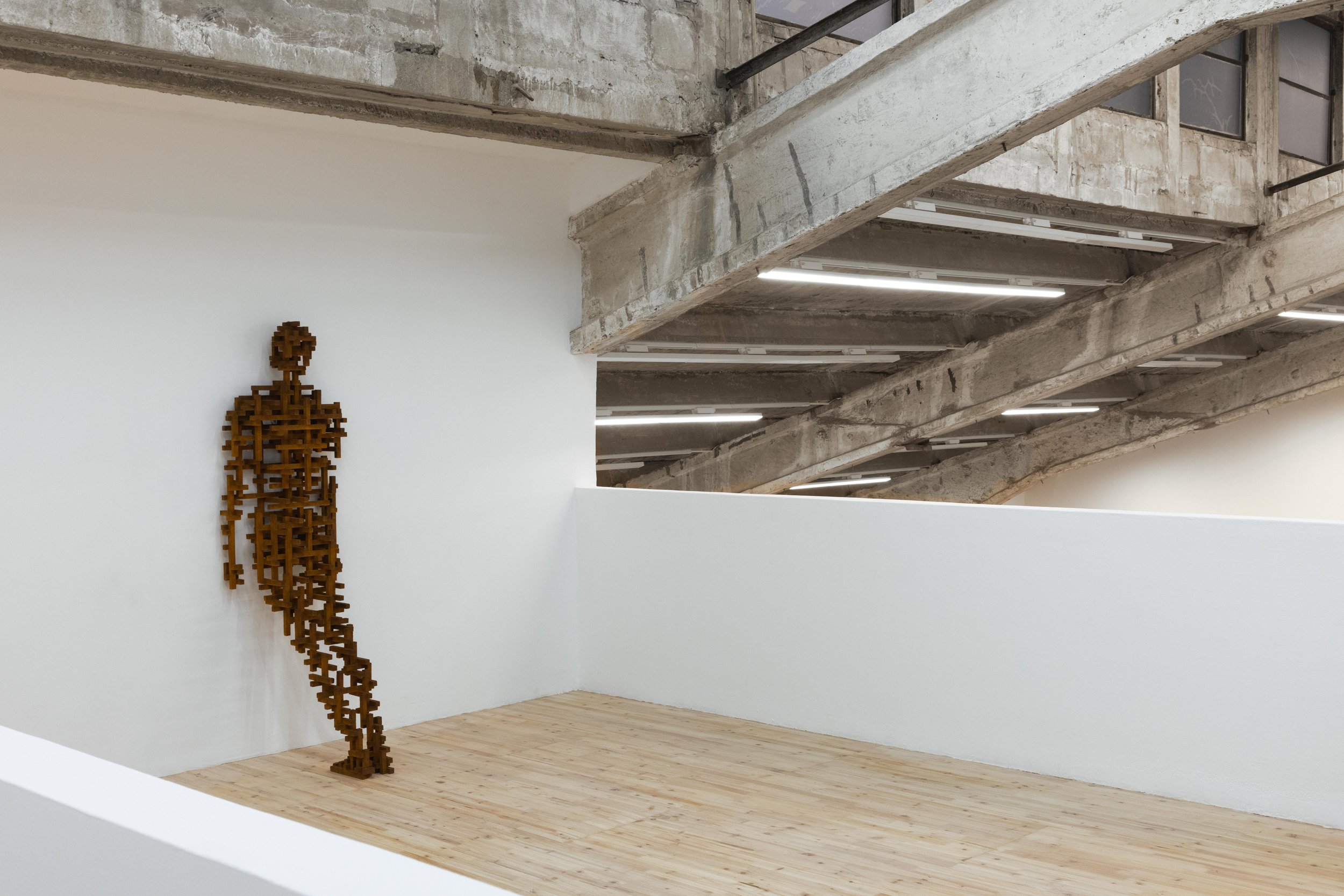BODY BUILDINGS BY ANTONY GORMLEY
Body Buildings, exhibition views, Galleria Continua / Beijing, 2024, Courtesy: the artist and GALLERIA CONTINUA, Copyright: © the Artist, Photographer: Huang Shaoli
Galleria Continua is pleased to present ‘Body Buildings’, Antony Gormley’s third solo exhibition at the 798 Art District in Beijing following ‘Another Singularity’ (2009) and ‘Host’ (2016). ‘Body Buildings’ interrogates our species’ relationship to the built environment, an increasingly high-rise world we rarely escape. In a significant group of recent sculptures and drawings, Gormley uses clay and iron, two ubiquitous materials of the built world, ‘to think and feel the body in this condition’.






Body Buildings, exhibition views, Galleria Continua / Beijing, 2024, Courtesy: the artist and GALLERIA CONTINUA, Copyright: © the Artist, Photographer: Huang Shaoli
The central work in the exhibition, Resting Place II, conjures a dense labyrinthine terrain that viewers are invited to enter and navigate. This field of 132 life-size bodies, each built from fired clay bricks stacked atop one another, investigates the body at rest as our primary dwelling place. For the artist, the brick is a ‘physical pixel’ that plays an important role in Chinese culture.
Constructed in different orthogonal yet precarious positions, the bodies evoke a range of conditions, from splayed relaxation to foetal self-protection. When viewed from the gallery’s first and second-floor balconies, the interplay between moving visitors and horizontal clay bodies creates a dynamic field in which the particularity of subjective experience is at work.
Body Buildings, exhibition views, Galleria Continua / Beijing, 2024, Courtesy: the artist and GALLERIA CONTINUA, Copyright: © the Artist, Photographer: Huang Shaoli
As Gormley has said: ‘Resting Place II evokes the human body’s relationship to the ground, the surface of the earth. It refers to two very different kinds of abandonment: the relaxed abandonment of the body on the beach, the place to which we return in childhood play and relaxation, and another, that of the migrant who has either forcibly or freely sought a new home. What at first looks like a chaotic display of building materials might resolve into the model of a city and further resolve into the invitation to empathise with the body as a place of indwelling, some evoking states of deep relaxation and contentment, others of retreat and defence.’
Body Buildings, exhibition views, Galleria Continua / Beijing, 2024, Courtesy: the artist and GALLERIA CONTINUA, Copyright: © the Artist, Photographer: Huang Shaoli
Accompanying Resting Place II are sculptures cast in iron, such as Circuit and Ally, which explore parallels between urban infrastructure—roads, electrical circuits, plumbing—and human relationships. Circuit transforms these networks into a circulatory system shared by two bodies, while Ally uses stacks of massive cast iron blocks to test how two bodies can find mutual stability through a shared centre of gravity. These explorations of proximity and intimacy ask to what extent the urban environment shapes and mirrors human connections.
On either side of Circuit are Short and Shame, two works that treat the body as an independent energy field in which the body veers from its centre of gravity, purposefully avoiding the stability associated with statues of power. In a series of tight knots, Shame identifies places of tension within the body—ankles, knees, pelvis, head and hands—while Short escapes the bounding condition of the skin as the iron lines move from inside the body to beyond its apparent surface.
Body Buildings, exhibition views, Galleria Continua / Beijing, 2024, Courtesy: the artist and GALLERIA CONTINUA, Copyright: © the Artist, Photographer: Huang Shaoli
On the gallery’s top floor, Rule III and Buttress transform body space into latticed scaffolding, familiar to us in the skeletons of contemporary high-rise architecture. In doing so, the works materialise the way that having made a world, it now makes us. The two rusting bodies are placed directly against the walls, implicating the architectural context and making visitors aware of their relationship to the built environment.
Body Buildings, exhibition views, Galleria Continua / Beijing, 2024, Courtesy: the artist and GALLERIA CONTINUA, Copyright: © the Artist, Photographer: Huang Shaoli
The sculptures are accompanied by a series of drawings. Singularity X and Event VII evoke the luminous beginnings of astral matter. They are complemented by a series of layered ‘Lux’ drawings that refer to apertures or sources of light glimpsed from within interiors. Other drawings made using inkcap mushroom ink as well as carbon and casein examine darkness as experienced inside the body and in proximity to another.
‘Body Buildings’ is an interrogation of the state of our species. Gormley offers these sculptures as diagnostic tools to examine our present condition.
Body Buildings, exhibition views, Galleria Continua / Beijing, 2024, Courtesy: the artist and GALLERIA CONTINUA, Copyright: © the Artist, Photographer: Huang Shaoli
The exhibition opened on November 14, 2024, and will close on April 15, 2025, at the Galleria’s location Beijing,798 Art Dst. 2 Jiuxianqiao Rd. Chaoyang Dst, Beijing. For more information about this exhibition and others at Galleria Continua please visit their site here. Galleria Continua can also be found on Instagram, Facebook, TikTok, YouTube, and Artsy.





